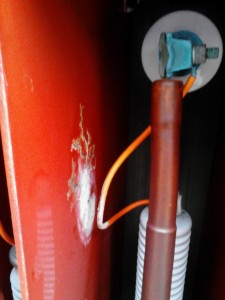MVA Electrical Power Transformer Destructive Tracking
If you’re a manufacturing plant and your main electrical power transformer is a 10 MVA, 10,000 kva, oil filled station type transformer, you’re probably not interested in failure modes and probability analysis from your service company. You just want to know everything is being done to make sure it doesn’t failure. In the world of sophisticated test procedures and test equipment and lengthy specifications for the application of the procedures to your 5 MVA, 10 MVA, or even 50 MVA high voltage power transformer, there is still need for old fashion maintenance and inspection services. Too often the main high voltage power transformer for a facility can never be turned off because of the interruption of production or data processing. We know that is the real world today and we have to deal with it in the best way possible to maintain reliability. Periodic combustible gas analyses and routine oil analysis are extremely useful. But there is still room for some old fashion basic maintenance services. MIDWEST likes “Ultrasonic Scanning” of medium voltage and high voltage equipment for indications of destructive corona or tracking. We recommend this on high voltage equipment, especially metal enclosed. And if you have a 20 MVA oil filled power transformer, you have something in front of it to protect it. If that protection fails, your transformer becomes very unhappy. For example, it is not unusual for us to find destructive corona or tracking damage to the inter-phase barriers in the high voltage switch protecting a power transformer. A good example is a lightning arrester lead that rests against the inter-phase barrier and is slowing destroying the barrier. Eventually one of the barriers will fail, usually a phase to phase fault and frequently during a lightning storm when a voltage surge screams down the line into the high voltage switch. Ultrasonic Scanning of the high voltage transformer main switch would catch this before it fails. Not real sophisticated, but an extremely effective preventive procedure. Find it, Fix it before it fails.
